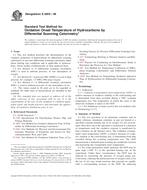Potřebujeme váš souhlas k využití jednotlivých dat, aby se vám mimo jiné mohly ukazovat informace týkající se vašich zájmů. Souhlas udělíte kliknutím na tlačítko „OK“.
ASTM E2009-08
Standard Test Method for Oxidation Onset Temperature of Hydrocarbons by Differential Scanning Calorimetry
Automaticky přeložený název:
Standardní zkušební metoda pro oxidační teplotou nástupu uhlovodíků diferenční skenovací kalorimetrií
NORMA vydána dne 1.9.2008
Informace o normě:
Označení normy: ASTM E2009-08
Poznámka: NEPLATNÁ
Datum vydání normy: 1.9.2008
Kód zboží: NS-43940
Počet stran: 5
Přibližná hmotnost: 15 g (0.03 liber)
Země: Americká technická norma
Kategorie: Technické normy ASTM
Anotace textu normy ASTM E2009-08 :
Keywords:
differential scanning calorimetry, differential thermal analysis, hydrocarbons, oxidation, oxidation induction time (OIT), oxidation onset temperature (OOT), oxidative stability, pressure differential scanning calorimetry, Differential scanning calorimetry (DSC), DSC container (pan) cleaning, Oxidation onset temperature, Oxidative stability, Pressure differential scanning calorimetry (PDSC), Differential scanning calorimetry (DSC), DSC container (pan) cleaning, Oxidation onset temperature
Doplňující informace
| Significance and Use | ||||||||||||||||
|
Oxidation onset temperature is a relative measure of the degree of oxidative stability of the material evaluated at a given heating rate and oxidative environment, for example, oxygen; the higher the OOT value the more stable the material. The OOT is described in Fig. 1. The OOT values can be used for comparative purposes and are not an absolute measurement, like the oxidation induction time (OIT) at a constant temperature (see Test Method E 1858). The presence or effectiveness of antioxidants may be determined by this test method. Typical uses of this test method include the oxidative stability of edible oils and fats (oxidative rancidity), lubricants, greases, and polyolefins.
|
||||||||||||||||
| 1. Scope | ||||||||||||||||
|
1.1 This test method describes the determination of the oxidative properties of hydrocarbons by differential scanning calorimetry or pressure differential scanning calorimetry under linear heating rate conditions and is applicable to hydrocarbons, which oxidize exothermically in their analyzed form. 1.2 Test Method A—A differential scanning calorimeter (DSC) is used at ambient pressure, of one atmosphere of oxygen. 1.3 Test Method B—A pressure DSC (PDSC) is used at high pressure, for example, 3.5 MPa (500 psig) oxygen. 1.4 Test Method C—A differential scanning calorimeter (DSC) is used at ambient pressure of one atmosphere of air. 1.5 The values stated in SI units are to be regarded as standard. No other units of measurement are included in this standard. 1.6 This standard does not purport to address all of the safety concerns, if any, associated with its use. It is the responsibility of the user of this standard to establish appropriate safety and health practices and determine the applicability of regulatory limitations prior to use. |
||||||||||||||||
| 2. Referenced Documents | ||||||||||||||||
|
Doporučujeme:
EviZak - všechny zákony včetně jejich evidence na jednom místě
Poskytování aktuálních informací o legislativních předpisech vyhlášených ve Sbírce zákonů od roku 1945.
Aktualizace 2x v měsíci !
Chcete vědět více informací? Podívejte se na tuto stránku.




 Cookies
Cookies
